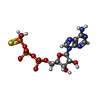+ Open data
Open data
- Basic information
Basic information
| Entry | Database: PDB / ID: 6ahf | |||||||||||||||||||||||||||||||||||||||||||||||||||||||||||||||||||||
|---|---|---|---|---|---|---|---|---|---|---|---|---|---|---|---|---|---|---|---|---|---|---|---|---|---|---|---|---|---|---|---|---|---|---|---|---|---|---|---|---|---|---|---|---|---|---|---|---|---|---|---|---|---|---|---|---|---|---|---|---|---|---|---|---|---|---|---|---|---|---|
| Title | CryoEM Reconstruction of Hsp104 N728A Hexamer | |||||||||||||||||||||||||||||||||||||||||||||||||||||||||||||||||||||
 Components Components | Heat shock protein 104 | |||||||||||||||||||||||||||||||||||||||||||||||||||||||||||||||||||||
 Keywords Keywords | CHAPERONE / Hsp / holdase | |||||||||||||||||||||||||||||||||||||||||||||||||||||||||||||||||||||
| Function / homology |  Function and homology information Function and homology informationtrehalose metabolic process / TRC complex / protein folding in endoplasmic reticulum / cellular heat acclimation / post-translational protein targeting to endoplasmic reticulum membrane / stress granule disassembly / : / protein unfolding / nuclear periphery / ADP binding ...trehalose metabolic process / TRC complex / protein folding in endoplasmic reticulum / cellular heat acclimation / post-translational protein targeting to endoplasmic reticulum membrane / stress granule disassembly / : / protein unfolding / nuclear periphery / ADP binding / unfolded protein binding / protein-folding chaperone binding / cellular response to heat / protein refolding / ATP hydrolysis activity / ATP binding / identical protein binding / nucleus / cytosol / cytoplasm Similarity search - Function | |||||||||||||||||||||||||||||||||||||||||||||||||||||||||||||||||||||
| Biological species |  | |||||||||||||||||||||||||||||||||||||||||||||||||||||||||||||||||||||
| Method | ELECTRON MICROSCOPY / single particle reconstruction / cryo EM / Resolution: 6.78 Å | |||||||||||||||||||||||||||||||||||||||||||||||||||||||||||||||||||||
 Authors Authors | Zhang, X. / Zhang, L. / Zhang, S. | |||||||||||||||||||||||||||||||||||||||||||||||||||||||||||||||||||||
| Funding support |  China, 1items China, 1items
| |||||||||||||||||||||||||||||||||||||||||||||||||||||||||||||||||||||
 Citation Citation |  Journal: J Biol Chem / Year: 2019 Journal: J Biol Chem / Year: 2019Title: Heat shock protein 104 (HSP104) chaperones soluble Tau via a mechanism distinct from its disaggregase activity. Authors: Xiang Zhang / Shengnan Zhang / Li Zhang / Jinxia Lu / Chunyu Zhao / Feng Luo / Dan Li / Xueming Li / Cong Liu /  Abstract: Heat shock protein 104 (HSP104) is a conserved AAA+ protein disaggregase, can disassemble the toxic aggregates formed by different amyloid proteins, and is protective in various animal models ...Heat shock protein 104 (HSP104) is a conserved AAA+ protein disaggregase, can disassemble the toxic aggregates formed by different amyloid proteins, and is protective in various animal models associated with amyloid-related diseases. Extensive studies have attempted to elucidate how HSP104 disassembles the aggregated form of clients. Here, we found that HSP104 exhibits a potent holdase activity that does not require energy, prevents the soluble form of amyloid clients from aggregating, and differs from HSP104's disaggregase activity. Using cryo-EM, NMR, and additional biophysical approaches, we found that HSP104 utilizes its small subdomain of nucleotide-binding domain 2 (ssNBD2) to capture the soluble amyloid client (K19 of Tau) independent of its ATP hydrolysis activity. Our results indicate that HSP104 utilizes two fundamental distinct mechanisms to chaperone different forms of amyloid client and highlight the important yet previously unappreciated function of ssNBD2 in chaperoning amyloid client and thereby preventing pathological aggregation. | |||||||||||||||||||||||||||||||||||||||||||||||||||||||||||||||||||||
| History |
|
- Structure visualization
Structure visualization
| Movie |
 Movie viewer Movie viewer |
|---|---|
| Structure viewer | Molecule:  Molmil Molmil Jmol/JSmol Jmol/JSmol |
- Downloads & links
Downloads & links
- Download
Download
| PDBx/mmCIF format |  6ahf.cif.gz 6ahf.cif.gz | 736.8 KB | Display |  PDBx/mmCIF format PDBx/mmCIF format |
|---|---|---|---|---|
| PDB format |  pdb6ahf.ent.gz pdb6ahf.ent.gz | 553.7 KB | Display |  PDB format PDB format |
| PDBx/mmJSON format |  6ahf.json.gz 6ahf.json.gz | Tree view |  PDBx/mmJSON format PDBx/mmJSON format | |
| Others |  Other downloads Other downloads |
-Validation report
| Summary document |  6ahf_validation.pdf.gz 6ahf_validation.pdf.gz | 1.6 MB | Display |  wwPDB validaton report wwPDB validaton report |
|---|---|---|---|---|
| Full document |  6ahf_full_validation.pdf.gz 6ahf_full_validation.pdf.gz | 2.4 MB | Display | |
| Data in XML |  6ahf_validation.xml.gz 6ahf_validation.xml.gz | 246.6 KB | Display | |
| Data in CIF |  6ahf_validation.cif.gz 6ahf_validation.cif.gz | 352.5 KB | Display | |
| Arichive directory |  https://data.pdbj.org/pub/pdb/validation_reports/ah/6ahf https://data.pdbj.org/pub/pdb/validation_reports/ah/6ahf ftp://data.pdbj.org/pub/pdb/validation_reports/ah/6ahf ftp://data.pdbj.org/pub/pdb/validation_reports/ah/6ahf | HTTPS FTP |
-Related structure data
| Related structure data |  9625MC M: map data used to model this data C: citing same article ( |
|---|---|
| Similar structure data |
- Links
Links
- Assembly
Assembly
| Deposited unit | 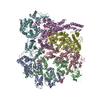
|
|---|---|
| 1 |
|
- Components
Components
| #1: Protein | Mass: 102130.938 Da / Num. of mol.: 6 / Mutation: N728A Source method: isolated from a genetically manipulated source Source: (gene. exp.)   #2: Chemical | ChemComp-AGS / Has protein modification | Y | |
|---|
-Experimental details
-Experiment
| Experiment | Method: ELECTRON MICROSCOPY |
|---|---|
| EM experiment | Aggregation state: PARTICLE / 3D reconstruction method: single particle reconstruction |
- Sample preparation
Sample preparation
| Component | Name: CryoEM Reconstruction of Hsp104 N728A Hexamer / Type: COMPLEX / Entity ID: #1 / Source: RECOMBINANT |
|---|---|
| Source (natural) | Organism:  |
| Source (recombinant) | Organism:  |
| Buffer solution | pH: 7.4 |
| Specimen | Embedding applied: NO / Shadowing applied: NO / Staining applied: NO / Vitrification applied: YES |
| Specimen support | Grid material: COPPER / Grid type: Quantifoil R1.2/1.3 |
| Vitrification | Cryogen name: ETHANE / Humidity: 100 % |
- Electron microscopy imaging
Electron microscopy imaging
| Experimental equipment |  Model: Titan Krios / Image courtesy: FEI Company |
|---|---|
| Microscopy | Model: FEI TITAN KRIOS |
| Electron gun | Electron source:  FIELD EMISSION GUN / Accelerating voltage: 300 kV / Illumination mode: OTHER FIELD EMISSION GUN / Accelerating voltage: 300 kV / Illumination mode: OTHER |
| Electron lens | Mode: OTHER |
| Specimen holder | Cryogen: NITROGEN |
| Image recording | Electron dose: 50 e/Å2 / Film or detector model: GATAN K2 SUMMIT (4k x 4k) |
- Processing
Processing
| Software | Name: PHENIX / Version: 1.10_2155: / Classification: refinement | ||||||||||||||||||||||||
|---|---|---|---|---|---|---|---|---|---|---|---|---|---|---|---|---|---|---|---|---|---|---|---|---|---|
| EM software | Name: PHENIX / Category: model refinement | ||||||||||||||||||||||||
| CTF correction | Type: PHASE FLIPPING AND AMPLITUDE CORRECTION | ||||||||||||||||||||||||
| 3D reconstruction | Resolution: 6.78 Å / Resolution method: FSC 0.143 CUT-OFF / Num. of particles: 69537 / Symmetry type: POINT | ||||||||||||||||||||||||
| Refine LS restraints |
|
 Movie
Movie Controller
Controller



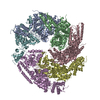


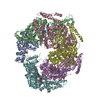

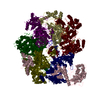
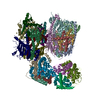
 PDBj
PDBj



